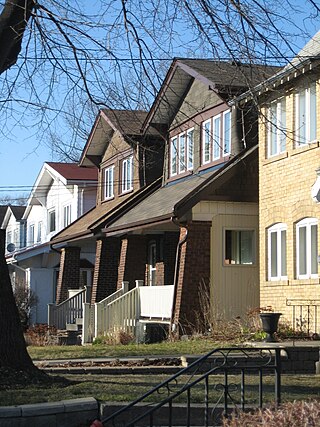Don, don or DON and variants may refer to:

The Greater Toronto Area, commonly referred to as the GTA, includes the City of Toronto and the regional municipalities of Durham, Halton, Peel, and York. In total, the region contains 25 urban, suburban, and rural municipalities. The Greater Toronto Area begins in Burlington in Halton Region, and extends along Lake Ontario past downtown Toronto eastward to Clarington in Durham Region.
ST, St, or St. may refer to:

A Canadian postal code is a six-character string that forms part of a postal address in Canada. Like British, Irish and Dutch postcodes, Canada's postal codes are alphanumeric. They are in the format A1A 1A1, where A is a letter and 1 is a digit, with a space separating the third and fourth characters. As of October 2019, there were 876,445 postal codes using Forward Sortation Areas from A0A in Newfoundland to Y1A in Yukon.

Uxbridge is a township in the Regional Municipality of Durham in south-central Ontario, Canada.
The telephone number prefix 555 is a central office code in the North American Numbering Plan, used as the leading part of a group of 10,000 telephone numbers, 555-XXXX, in each numbering plan area (NPA). It has traditionally been used only for the provision of directory assistance, when dialing -555-1212.
Area codes 905, 289, 365, and 742 are telephone area codes in the North American Numbering Plan (NANP) for the Golden Horseshoe region that surrounds Lake Ontario in Southern Ontario, Canada. The numbering plan area (NPA) comprises (clockwise) the Niagara Peninsula, the city of Hamilton, the regional municipalities of Halton, Peel, York, Durham, and parts of Northumberland County, but excludes the City of Toronto.

Area codes 416, 647, and 437 are telephone area codes in the North American Numbering Plan (NANP) for the city of Toronto, Ontario, Canada. Area code 416 is one of the original North American area codes created by the American Telephone and Telegraph Company (AT&T) in 1947. Area codes 647 and 437 are additional area codes for the same numbering plan area (NPA), forming an overlay numbering plan.
In telecommunications, an area code overlay complex is a telephone numbering plan that assigns multiple area codes to a geographic numbering plan area (NPA). Area code overlays are implemented in territories of the North American Numbering Plan (NANP) to mitigate exhaustion of central office codes in growth areas. The method has been in use since 1992, and has been the preferred and exclusive method of relief since 2007.
F9, F09, F.IX, F 9 or F-9 may refer to:

Lester B. Pearson International Airport, commonly known as Toronto Pearson International Airport, or simply Toronto Pearson or Pearson, is an international airport located in Mississauga, Ontario, Canada. It is the main airport serving Toronto, its metropolitan area, and the surrounding region known as the Golden Horseshoe. The airport is named in honour of Lester B. Pearson, who served as the 14th Prime minister of Canada and received the Nobel Peace Prize in 1957 for his humanitarian work in peacekeeping.
Area codes 506 and 428 are the telephone area codes in the North American Numbering Plan (NANP) for the Canadian province of New Brunswick. Area code 506 was created in 1955 in a split of numbering plan area (NPA) 902. Area code 428 was added to the same numbering plan area in 2023 to form an overlay plan of the area.

Area code 709 is the telephone area code in the North American Numbering Plan (NANP) for the entire Canadian province of Newfoundland and Labrador.
M is the thirteenth letter of the modern Latin alphabet.
Twilight Zone may refer to:

The Upper Beaches is a neighbourhood in Toronto, Ontario, Canada. It is directly north of the Beaches area. It stretches from Coxwell Avenue in the west to Victoria Park in the east. The southern border is Kingston Road, while the northern boundary is generally considered to be the Canadian National Railway tracks between Gerrard Street and Danforth Avenue. The western part of the area was originally called Norway, and the larger area was once part of the Town of East Toronto. The name "Upper Beaches" was first used by developers and real estate agents around the period of 2001 to 2003 for the selling of houses on redeveloped land in the area, and was used as a marketing tag to attract buyers. The area was never considered part of the Beaches neighbourhood but was close to it. The city's current name for this area is East End Danforth, though that is rarely used. The city also includes the buildings along and just north of Danforth Avenue in the neighbourhood. The western portion between Woodbine Avenue and Coxwell is referred to by the city as Woodbine Corridor.

Gerrard India Bazaar, also known as Little India, is a commercial South Asian ethnic enclave in the Leslieville neighbourhood of Toronto, Ontario, Canada. It is entirely situated along a portion of Gerrard Street (E), Toronto, between Greenwood Avenue and Coxwell Avenue, constituting the seventh largest South Asian marketplaces in North America.
In the administration of the North American Numbering Plan, central office code protection is a numbering policy for maintaining local seven-digit dialing in communities that extend on both sides of the boundary line between multiple numbering plan areas (NPAs), such as in cross-border towns on state lines. Code protection prevents the use of the same telephone number on both sides by not assigning the same central office code of one NPA in the adjacent NPA.







